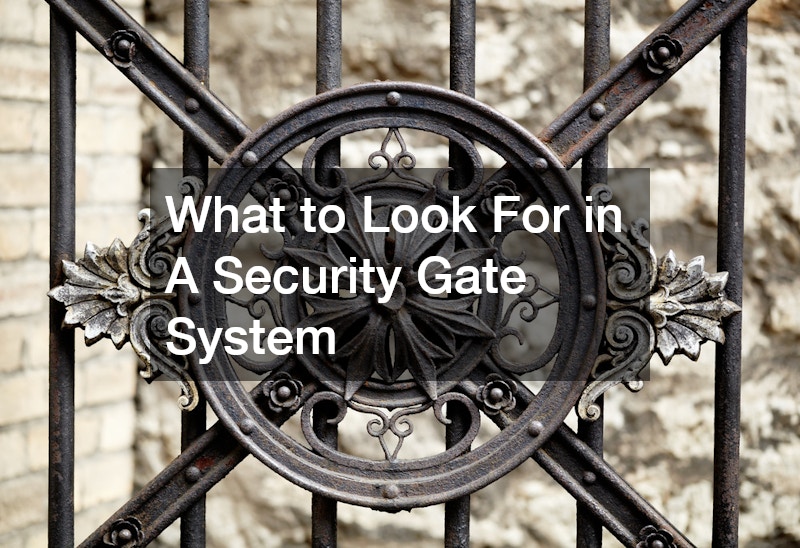
Security gate systems are an essential aspect of safeguarding both residential and commercial properties. They provide a first line of defense against potential intruders, help control access to the premises, and can significantly augment the peace of mind for property owners. In this article, we will explore the key features and considerations to bear in mind when selecting a security gate system.
Video Source
Understanding these elements will enable you to make an informed decision tailored to your specific needs.
Understanding the different types of security gate systems is crucial for making an informed choice. There are primarily three types of gates: sliding gates, swinging gates, and bi-folding gates. Sliding gates operate by moving horizontally on a track, making them ideal for properties with limited space. Swinging gates, conversely, open inward or outward like a door, requiring more space but offering a classic aesthetic. Bi-folding gates, a modern solution, consist of panels that fold upon entry, offering a balance between space-saving and aesthetic appeal.
Beyond the physical operation, gates can vary from manual to fully automated solutions. Manual gates require physical effort to open and close, potentially compromising convenience. Automated gates, however, utilize electric or solar power for operation, offering increased security and user convenience. Automations can include features like remote control access, keypad entry, or even smartphone integration for seamless operation.
Additionally, security gates are available in various materials, including wood, steel, and aluminum. Each material offers different benefits: wood provides a natural aesthetic but requires maintenance; steel is robust and secure but can be prone to rust; aluminum offers a lightweight, rust-resistant option but might not match the strength of steel. Your choice can depend on aesthetic preferences, budget constraints, and security needs.
Modern security gates come equipped with a variety of features that enhance safety and security. One of the key advancements is the integration of automatic locking systems. These systems ensure that once a gate is closed, it automatically locks, reducing the risk of human error. Keypad or biometric access adds an additional layer of security, ensuring that only authorized individuals can gain access.
Another feature incorporated in advanced gates is the use of surveillance technology. Many security gates are equipped with cameras that provide a live feed or recording of entrance activities. This feature not only acts as a deterrent to potential intruders but also provides valuable footage in the event of a security incident. Additionally, modern systems often include sensors or motion detectors that trigger alarms under suspicious conditions.
The utility of smart technologies in gates is also prominent. Integration with home automation systems allows gates to be controlled remotely via smartphone apps. This means homeowners can grant access or monitor gate activity from anywhere in the world. This added connectivity is a significant leap forward in ensuring the safety and convenience are at the forefront of security gate designs.
Several factors influence the cost of implementing a security gate system. One primary consideration is the type of gate you choose. Automated gates are more expensive than manual ones due to the technology and installation complexity involved. Similarly, the material you choose will affect the overall cost. For instance, steel gates are generally pricier than aluminum due to their durability.
Additionally, the size and design of the gate can heavily influence costs. Custom designs tailored to specific aesthetic preferences or unique property dimensions can increase manufacturing and installation expenses. Furthermore, the incorporation of advanced security features, like integrated cameras or high-end access control systems, also contributes significantly to the overall cost.
Installation and maintenance are ongoing cost considerations. Ensuring proper installation is essential for the optimal functioning of gate systems, often requiring professional services. Maintenance, especially for automated systems, is necessary to ensure long-term operation, and the cost of upkeep can vary depending on the complexity and technology of the system.
Selecting the right security gate involves assessing your specific needs and aligning them with available options. Begin by evaluating the primary purpose of the gate. Is it solely for security, or is aesthetics equally important? Determining your primary goal will guide your selection process, whether you prioritize automation, style, or materials.
Another critical factor is the property's layout. A sliding gate may be unsuitable for a steep driveway, whereas a swing gate might require more clearance space than available. Consider the space and topographical limitations of the installation site, and choose a gate design that complements your property's unique configuration.
Ultimately, budget will play a significant role in your choice. Balance your financial constraints with desired features and security needs. It's often beneficial to consult with professional security experts who can tailor recommendations based on your requirements and ensure that the selected gate meets all necessary safety standards.
Choosing the right security gate system involves careful consideration of various factors including type, technology, cost, and personal requirements. By understanding these elements, you can make a well-informed decision that provides the security you need. Effective integration of modern technology can significantly augment safety and operational convenience, ensuring your property is protected from unauthorized access. Investing time in understanding the diverse options and intricacies of security gate systems will ultimately result in a solution that enhances both the security and value of your property.
